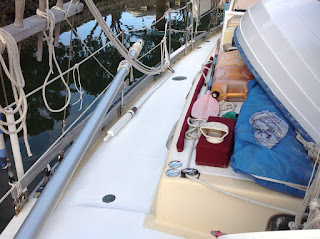So, the poo tank was only half of the whole renovation project for the head. The other half involved the bench top — what is called a counter in the States is called a bench here in New Zealand — the bench front, the storage area underneath, and the shower pan.
The bench top was fairly easy. I pried the old Formica off, made a pattern of the surface, made a quarter-inch plywood piece from that pattern, and had some new Formica bonded onto it. Then I epoxied it down onto the old sublayer. Pretty straightforward. The rest of the bench joinery was more involved.
The original bench front had only one small door. Now that we had eliminated the through-hull fitting under the bench, along with the associated hoses, we had a lot more room there, and needed better access. So, I cut out the bench front, leaving a four-inch frame around the opening. Then I made a new bench front, this one with two doors, one of which is quite large. I also made two shelves in this area, to make better use of the space.
The shower pan was the most complex part. The original one was simply a flat area under the teak grate, with drain holes in the middle of the flat. That pretty much guaranteed that it wouldn’t fully drain. The pan, as well as the area around the toilet, was also painted with a one-part paint of some kind, which did not adhere well in the often wet environment. We have dealt with peeling paint there for the past sixteen years. Well, NO LONGER! Now the whole area is painted with a two-part polyurethane, an appropriate coating for such an area. But I’m getting ahead of myself.
The pan is also no longer flat. I cut out a rectangular opening in the pan, fabricated a well underneath that opening (which sloped down to a drain at the lowest point), and reshaped the area of the pan around said well so that it was sloped on all sides. Now, it drains fully, and cleans easily. I’ll spare you the details, but it involved quite a bit of epoxy bog, and a LOT of sanding.
 |
| Shower pan and toilet base stripped, with the hole for the well cut out |
 |
| The well |
 |
| Well in place, and sides of pan sloped |
 |
| Finished pan |
 |
| Shelves and doors |
 |
| Finished job |
Another major improvement complete.







